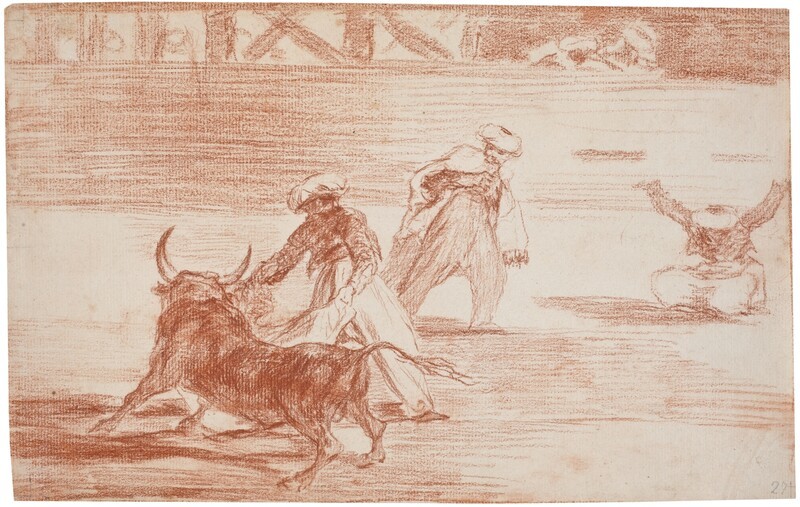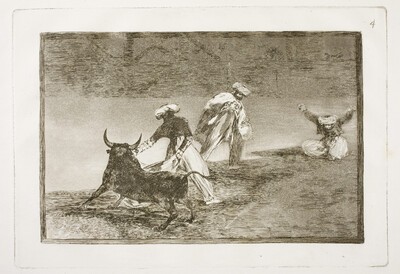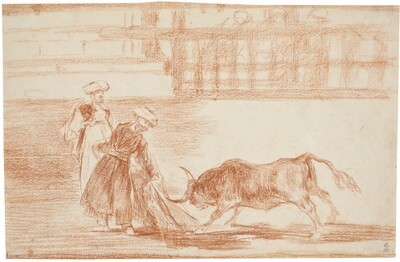- Cronología
- Ca. 1814 - 1816
- Ubicación
- The Prado National Museum. Madrid, Madrid, Spain
- Dimensiones
- 189 x 297 mm
- Técnica y soporte
- Sanguine on laid paper
- Reconocimiento de la autoría de Goya
- Documented work
- Titular
- El Prado National Museum
- Ficha: realización/revisión
- 01 Oct 2021 / 22 Jun 2023
- Inventario
- D4292
27 (in pencil; recto, lower right-hand corner)
2 [Under the annotation "Engraved"] (verso, upper middle)
211 [Under the figure "212"] (verso, lower left)
212 [crossed out] (verso, lower left)
43 (reverse, upper right)
Engraving (reverse, upper centre)
Watermark: J HONIG / & / ZOONEN [Large beehive with letters "HONIG" between vegetal scrolls with a flower above, and below the letters "J H & Z"].
See How the ancient Spaniards hunted bulls on horseback in the countryside.
Javier Goya, Madrid, 1828; Mariano Goya, Madrid, 1854; Valentín Carderera, Madrid, c. 1861; Mariano Carderera, Madrid, 1880; Prado Museum, 1886.
See How the ancient Spaniards hunted bulls on horseback in the countryside.
This scene is the preparatory drawing for the print Capes another enclosed, which depicts a square enclosed by barriers with three figures depicted as three Mamluk soldiers in Napoleon's service during the War of Independence. According to Matilla, the strange pose of a kneeling Moor, similar to the prayer pose in a mosque, is striking at the moment when one of the figures is fighting a large, long, dark bull.
As Matilla explains, Goya depicts the Moors in clothing that does not correspond to the Middle Ages in which the action was supposed to take place, presenting them as imperial Turks. The garment has been criticised for being clearly anachronistic and reveals Goya's intention to remake the history of bullfighting from images he himself witnessed. One of the most interesting features of this scene is the presence of a burladero with spectators, as in the print The Moors are doing another bullfight in the bullring in their bathrobes.
The figures of the main characters are quite accurate, but the figures of some of the spectators behind the stage seem incomplete. Nevertheless, they play an important role in the composition of the series, especially in the modern scenography, as they give clues as to the artist's true position on this bullfighting festival. In addition, Goya used light to accentuate and give movement to the figures.
The composition was transferred to the engraving with hardly any modifications.
-
Santander2017cat. 67
-
Madrid2019cat. 134
-
Roma D.Anderson: Editeur1908pp. il. CIX
-
1946pp. 185, 188-189.
-
MadridMuseo del Prado1954nº 154
-
ParísLe Club Français du Livre1963p. 50
-
Vie et ouvre de Francisco de GoyaParísOffice du livre1970p. 276, nº 1156
-
BarcelonaEditorial Gustavo Gili, S.A1974pp. 10-11
-
Dibujos de Goya, 2 volsBarcelonaNoguer1975pp. 336-337, nº 243
-
MadridSilex1980p. 146, nº 48
-
MadridMuseo Nacional del Prado2001pp. 46-48, [127]
-
Goya en tiempos de guerraMadridMuseo Nacional del Prado2008pp. 420-421
-
SantanderFundación Botín y Museo Nacional del Prado2017pp. 116, n. 67
-
MadridMuseo Nacional del Prado2019p. 215



